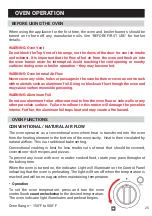
BEFORE FIRST USE
CLEAN
•
Remove any packaging and protective films.
•
Remove any residue oil or grease from the manufacturing process:
COOKTOP:
Wash the removable parts (Burner Grates, Burner Caps and Burner Heads)
of the cooktop in a mild solution of warm water and liquid dish soap. Dry thoroughly.
Wipe the cooktop surface with a damp cloth and dry thoroughly. Assemble the burner
parts in the correct order. (See ‘COMPONENT PART ASSEMBLY’.)
OVEN:
Wash the oven racks in a mild solution of warm water and liquid dish soap and
dry. Wipe down the interior of the oven and the Oven Rack Guides with a clean damp
cloth. Dry thoroughly before installing the parts. (See ‘COMPONENT PART ASSEM-
BLY’.)
IMPORTANT: The oven and broiler should be turned on to burn off the manufacturing
oils. Turn the Oven to 450°F for 20 to 30 minutes. Then turn the Oven to ‘BROIL’ for
the same length of time. You may wish to turn on the ventilator above your range at
this time. Turn the oven off and allow to cool with the door closed.
CHECK
• Once the gas and power are connected, check that all range controls are in the “off”
position and turn on the main gas supply valve.
•
Check for gas leaks at all gas connections (using a gas detector, never a flame).
•
Check ignition of cooktop burners.
•
Check the flame. When properly installed, the flame will be steady and quiet and
approximately 1” in height.
•
Check ignition of oven burner.
• Visually check heating elements of the oven. Carefully lift the panel on the interior
floor of the oven. Turn on the oven to check the heating element heats fully. Turn off
the oven and allow to cool before returning the floor panel.
• Visually check the broil heating element.
• Check operation of the convection fan.
IMPORTANT:
•
Metal components have a protective coating which may give off a slight odor the
first time your new appliance is heated.
•
The harmless odor will dissipate after a short time and does not indicate a faulty
connection or appliance defect.
20
A
B
C
NG
LP
Yellow at tip of
primary flame
1”
Service
Required
When burning natural gas (NG), the burner
flames should be sharp and almost completely
blue with possibly a small hint of yellow in the
center of the flame as seen in figure ‘A’.
When burning liquid propane (LP), the flames
will usually have a yellow tip as seen in figure ‘B’.
If the flame is mostly yellow in color as seen in
figure ‘C’, this indicates a problem. Discontinue
use and seek assistance from a licensed gas
service. Note: foreign material in the gas line
may cause an orange flame during initial opera-
tion.















































